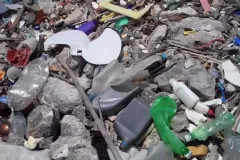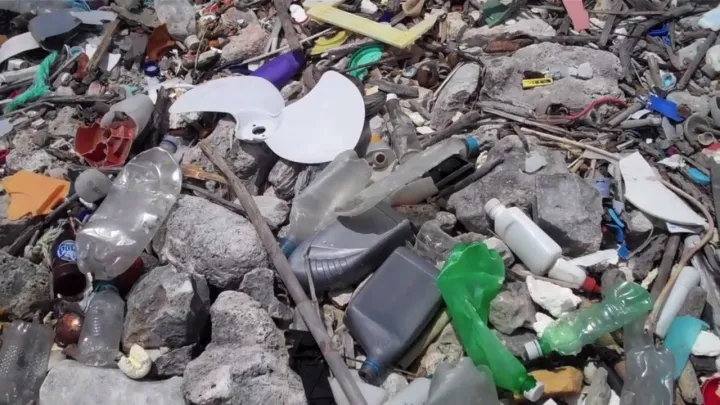Ocean Trash: Marine Debris From Shore to Sea

We drove down a long dirt road on the northern side of Curaçao looking for a remote place to snorkel and sample. After a 30-minute bumpy ride, our team stepped out of the car into a breeze and the sounds of wind and crashing waves. It’s a moment I will never forget; although no one was in sight for miles, the evidence of human activity was apparent. We had stepped onto a shoreline blanketed in garbage.
We were on the northern and windward side of the island, so we wondered if the trash came from the ocean, or if the site might be an old dump, or one still in use. Regardless of where it came from, it was here to stay, unless the tide carried some back out to sea.
I started thinking about the large amount of marine debris, much of it plastic, in the ocean. I thought of the Eastern Pacific Garbage Patch, a large area of garbage floating in the Pacific Ocean. There is a common misconception that the trash is simply on the surface, but the facts are a bit more disturbing. While large patches of plastic exist, much of it is small and suspended throughout the water column, and the trash is widely dispersed due to wind and water currents. Another misconception is that marine debris is a problem confined to the Pacific Ocean, when in fact it is a global issue.
This summer, Deep Reef Observation Project (DROP) scientists saw tires, beer bottles, and even a plastic grocery bag floating below 30 meters (100 ft, shown in the above video taken from a submersible). Few people get to see the deep sea firsthand and although it is typically out of sight, it should not be out of mind.
I was saddened when I saw these familiar items in the deep reef and on the coast. I wanted to pick up every bottle, fishing net, foam piece, and lonely shoe I saw. All of this made me feel so helpless; it was a big beach and a big ocean and I was just one person! But then it struck me: all this was here because of the collective actions of many individuals.
How many plastic bags, bottles and other disposable items have I used in my lifetime? Although our group could not clean up the beach that afternoon, I thought about what I could do back home to make a difference. And while I try and make eco-friendly choices, I knew I could make a few more changes to use less plastic.
Ever since this experience, I have been consistently using my reusable grocery bags. I’ve also started to notice and avoid food and products needlessly packaged with excess plastic. And I was happy to find that many coffee shops give discounts for using your own cup. Although it is almost impossible to completely avoid using plastics in our daily lives, it is very easy to recycle, reduce, and reuse.
A lifetime of personal choices can really add up. Consider holding on to that empty plastic bottle an extra 5 minutes until you find a recycle bin or make a small investment in reusable containers. Educate yourself about marine debris, learn how trash travels, and how to make your daily routine a little more green… or blue. So take some steps to be there for our planet and share what you learn with others. Don’t be afraid to talk trash!
Editor's Note: This is the fourth post in our "Summer in a Sub" blog series, which features the work of the Smithsonian's Deep Reef Observation Project (DROP).


